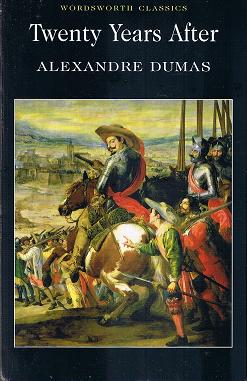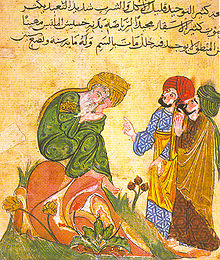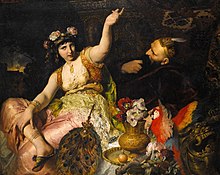
Twenty Years After
 | |
| Author | Alexandre Dumas in collaboration with Auguste Maquet |
|---|---|
| Original title | Vingt ans après |
| Cover artist | Maurice Leloir |
| Country | France |
| Language | French |
| Genre | Historical, romantic |
Publication date
| January to August 1845 |
The novel follows events in France during the Fronde, during the childhood reign of Louis XIV, and in England near the end of the English Civil War, leading up to the victory of Oliver Cromwell and the execution of King Charles I. Through the words of the main characters, particularly Athos, Dumas comes out on the side of the monarchy in general, or at least the text often praises the idea of benevolent royalty. His musketeers are valiant and just in their efforts to protect young Louis XIV and the doomed Charles I from their attackers.
Contents
Synopsis[edit]
This section's plot summary may be too long or excessively detailed. (January 2016) (Learn how and when to remove this template message)
|
This section may need to be rewritten entirely to comply with Wikipedia's quality standards. (January 2016)
|
D'Artagnan and Mazarin[edit]
The action begins during the regency of Queen Anne of Austria (term 1643–1651), with Cardinal Mazarin as First Minister. D'Artagnan, who seemed to have a promising career ahead of him at the end of The Three Musketeers, has for twenty years remained a lieutenant, and seems unlikely to progress despite his ambition and the debt the queen owes him. He is summoned by Mazarin, who requires an escort; the French people detest Mazarin, and are on the brink of rebellion (La Fronde). D'Artagnan is sent to the Bastille to retrieve a prisoner, who turns out to be his former adversary, the Comte de Rochefort.After renewing his acquaintance with d'Artagnan and making a promise to aid his advancement, Rochefort is brought to his audience with Mazarin, where he learns that the cause for his imprisonment was his refusal to serve Mazarin at an earlier stage. He does, however, remember his promise, and though he offers his own service to Mazarin, he refuses to watch over the Duc de Beaufort, who is imprisoned at the time, and soon learns that, in consequence, he is to be returned to the Bastille, though this does not deter him from speaking highly of the achievements of d'Artagnan and the Three Musketeers.
Having determined that d'Artagnan is the man he seeks, Mazarin enters the chambers of the Queen to let her know that he has enlisted the man who had served her so well twenty years earlier. The Queen, feeling guilty for having forgotten d'Artagnan's service, gives Mazarin a diamond ring to return to d'Artagnan, one which she had previously given him that d'Artagnan sold. The avaricious Mazarin merely uses the diamond to show d'Artagnan that he is once again to enter the Queen's service. He commissions d'Artagnan to go in search of his friends.
Reunion of the Four Musketeers[edit]
D'Artagnan is at a loss; he has completely lost touch with his friends, who have resumed their real names. Athos, the Comte de la Fère, had returned to his estate near Blois; Porthos, Monsieur du Vallon, had married a lawyer's widow; and Aramis became a priest, the Abbé d'Herblay. Fortune intervenes when Planchet, his old servant, enters d'Artagnan's chambers, attempting to escape arrest for aiding the escape of Rochefort. Through Planchet, he locates Bazin, Aramis' old servant, now beadle at Notre Dame. Though Bazin is unwilling to help, d'Artagnan is able to find out, through an altar boy, that Bazin makes frequent visits to Noisy. D'Artagnan and Planchet go there, where they are set upon by a group who think them Frondeurs while outside the house of Madame de Longueville. When this group is satisfied that d'Artagnan is not the man they seek, Aramis surprises Planchet by dropping onto his horse from the tree in which he had been hiding.D'Artagnan finds that the former musketeer, who had thought of little other than being a priest, is now a priest who thinks of little other than being a soldier. Aramis is not willing to enter into Mazarin's service, however. D'Artagnan leaves but waits in hiding, suspecting that Aramis is both the Frondeur who had been sought earlier and the lover of Madame de Longueville. His suspicions are confirmed.
The visit to Aramis was not fruitless, as it yielded the address of Porthos. When d'Artagnan arrives at Porthos' estate he finds Mousqueton, who is overjoyed to meet d'Artagnan and Planchet. He finds that Porthos, despite his wealth and life spent in pursuit of amusement, is not happy. Porthos desires to become a baron, and with this bait d'Artagnan lures him into Mazarin's service.
D'Artagnan then continues his search for Athos, whom he finds almost completely changed, to be an example to his ward, Raoul. Though Athos will not be enlisted into Mazarin's service, and indeed reveals that his sympathies lie against Mazarin, the two arrange to meet again in Paris; Athos wishes to bring Raoul there to help him to become a gentleman, and also to separate him from Louise de la Vallière, with whom Raoul is obsessively in love. In Paris, Athos visits Madame de Chevreuse, the former mistress of Aramis, with whom, under the name Marie Michon, Aramis had much communication in The Three Musketeers. Athos reveals, discreetly, that Raoul is the son born of a chance encounter he had with her, and through her gets a letter of recommendation for Raoul to join the army.
The Duc de Beaufort[edit]
The scene then changes, to focus on the Duc de Beaufort, Mazarin's prisoner at Vincennes, who finds a new jailer, Athos' servant, the silent Grimaud. Grimaud instantly makes himself disagreeable to the Duc, as part of an escape plot. Using messages passed to Rochefort using tennis balls, they arrange to have a meal on Whitsuntide, to which La Ramée, second in command of the prison, is invited. The escape is successful, but d'Artagnan and Porthos are in pursuit.After a race against time, and having defeated several adversaries along the way, Porthos and d'Artagnan find themselves in the dark, surrounded, with swords crossed against adversaries equal to them, who are revealed to be Athos and Aramis. The four arrange to meet in Paris at the Place Royale; both parties, now finding themselves enemies, enter fearing a duel, but they reconcile and renew their vows of friendship.
Enter Mordaunt[edit]
As this is going on, Raoul is travelling to join the army. Along the road he sees a gentleman of around the same age, and tries to make haste to join him. The other gentleman reaches the ferry before him, but has fallen into the river. Raoul, who is used to fording rivers, saves the gentleman, the Comte de Guiche, and the two become friends. Further along the road, the debt is repaid when the Comte saves Raoul when they are attacked by Spanish soldiers. After the fight, they find a man close to death who requests the last rites. They help him to a nearby inn and find a traveling monk. This monk is unpleasant to them and does not seem inclined to perform this service, so they force him to go to the inn. Once there, the monk hears the confession. The dying man reveals that he was the executioner of Béthune and confesses his part in the execution of Milady de Winter. The monk reveals himself as her son, John Francis de Winter, who calls himself Mordaunt after Charles I stripped him of all his titles. Mordaunt stabs the executioner.Grimaud, who is to join Raoul, comes upon the inn just as this is taking place, though too late to prevent it, or to detain the monk. After hearing what happened from the dying man, making his excuses to Raoul, he departs to warn Athos about the son of Milady. After his departure, Raoul and Guiche are forced to retreat when the Spanish come upon the town. After joining the army of the Prince de Condé, Raoul provides assistance in interrogating the prisoner brought by Guiche and him, when the prisoner feigns to misunderstand them in several languages. Once they have learned the location of the Spanish army, they set out for battle, Raoul accompanying the Prince.
Meanwhile, d´Artagnan and Porthos help Queen Anne of Austria, the young Louis XIV and Mazarin escape Paris after its citizens finally start a rebellion by using children's slings (frondes) to hurl stones at the windows of Mazarin's associates. The champion of the French populace and parliament, Pierre Broussel, is arrested, but then released when it becomes clear that his imprisonment has only served to stir the crowd up worse. D´Artagnan meets the young king and watches over him as some Frondeurs - including Planchet, under a false name - who wanted to make sure that the king and queen were not about to escape, enter the king's bedroom demanding to see him. Immediately after this, he contrives for all of the royal household to escape from Paris anyway, bluffing his way past Planchet at the gates (the two men retain their friendship despite their differing allegiances in this conflict). After that, Mazarin sends d'Artagnan and Porthos to England with a message for Cromwell and orders them to stay there for some time under Cromwell's command. At the same time, Queen Henrietta of England meets the Musketeers' old English friend, Lord de Winter - a Royalist come to ask for French assistance for King Charles I of England, her husband, in the English Civil War and sends Athos and Aramis to England as well. So once again the two pairs of Musketeers find themselves on opposite sides: but Athos and Aramis, on the occasion of departing, are recognised by Mordaunt, who has been following Lord de Winter in the hope of finding his friends.
In England[edit]
Milady's son, Mordaunt, now twenty-three, reprises his role as one of the chief antagonists, and sets about avenging his mother's death. He seeks not only Lord de Winter, but the other four unknown conspirators who took part in his mother's clandestine "trial" and execution. He murders his uncle, Lord de Winter, who was Milady's brother-in-law, during the same battle in which King Charles I is captured. Athos and Aramis are captured by d'Artagnan and Porthos who are fighting alongside Mordaunt and Cromwell's troops. As soon as they can have a conversation, Athos talks d'Artagnan and Porthos into helping save Charles I. D'Artagnan and Porthos free their friends and start making plans in order to try to save the king.In the end, all their plans fail and Mordaunt turns to regicide, executing King Charles I after d'Artagnan and the three former Musketeers have kidnapped the real executioner in order to prevent this. D'Artagnan and his friends later confront Mordaunt at Cromwell's London residence, but in the course of a duel with d'Artagnan he escapes through a secret passage.
The Frenchmen and their servants leave England by ship, but Mordaunt gets aboard and blows it up. Unfortunately for him, the Musketeers' servants discover the explosives on board, rouse their masters, and contrive to steal the only lifeboat before the ship can blow up, leaving Mordaunt aboard. Mordaunt escapes the blast, and pleads with the Musketeers to let him into their boat. With the exception of Athos, they contemptuously reject his appeals. Athos insists on saving him, but as he helps him into the boat, Mordaunt deliberately drags him under the water where they struggle and Mordaunt is killed.
Athos rejoins the others stating: "I had a son. I wanted to live." This seems to confirm what d'Artagnan has long suspected, that the reason Athos's ward, Raoul de Bragelonne whom he adopted after he was abandoned by his mother, bears such a resemblance to him is because he is Athos's natural son.[1] Athos further states that "It was not me who killed him. It was fate."
Finale[edit]
Once back in France, the four friends go separate ways. D'Artagnan and Porthos head to Paris through a different route from Athos and Aramis, knowing that Mazarin will not forgive their disobedience. Aramis and Athos reach Paris only to find out that their friends have not. After looking for D'Artagnan and Porthos, they learn the duo has been imprisoned by Mazarin in Rueil. Athos tries to persuade Queen Anne to free his friends, but is imprisoned as well.After this, d'Artagnan manages to escape with Porthos and capture Mazarin. Mazarin is taken to one of Porthos's castles and he makes some concessions to the four friends in exchange for his freedom. These include creating Porthos a baron and making d'Artagnan a Captain of Musketeers. Athos asks for nothing: Aramis asks for concessions towards himself and his friends in the Fronde. These concessions are later accepted by Queen Anne, who finally realizes she has been rather ungrateful to d'Artagnan and his friends.
At the end of the novel, the first Fronde comes to an end and Mazarin, Queen Anne, and Louis XIV enter Paris. A riot takes place during which d'Artagnan accidentally kills Rochefort and Porthos kills Bonacieux (who in the earlier novel was d'Artagnan's landlord and an agent of Richelieu and is now a beggar and Frondist). At the end the four friends once again go their separate ways. D'Artagnan stays in Paris with Mazarin and Queen Anne; Athos returns to la Fère; Aramis returns to his abbey in Noisy le Sec; and Porthos returns to his castle to enjoy his baronage.
See also[edit]
- Musketeers Twenty Years After
- The Return of the Musketeers, a motion picture based on the novel.
References[edit]
- ^ http://www.online-literature.com/dumas/twenty_years, Chapter XV
| French Wikisource has original text related to this article: |
- Twenty Years After, Alexandre Dumas, ed. David Coward. Oxford World's Classics edition ( ISBN 0-19-283843-1)
| English Wikisource has original text related to this article: |
External links[edit]
- Twenty Years After at Project Gutenberg
- Twenty Years After at Faded Page (Canada)
 Twenty Years After public domain audiobook at LibriVox
Twenty Years After public domain audiobook at LibriVox
Categories:
- 1845 French novels
- Cultural depictions of Cardinal Mazarin
- Novels by Alexandre Dumas
- The Three Musketeers
- French historical novels
- French novels adapted into films
- Novels first published in serial form
- English Civil War novels
- Works about Louis XIV of France
- Sequel novels
- Novels set in Early Modern France
- Cultural depictions of D'Artagnan


